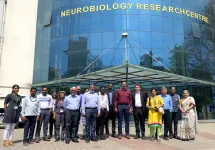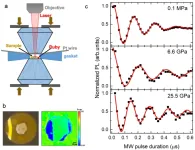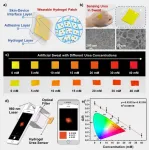(Press-News.org) Philadelphia, February 22, 2023 – In recent years, wearable devices such as smartwatches and rings, as well as smart scales, have become ubiquitous – “must-haves” for the health conscious to self-monitor heart rate, blood pressure, and other vital signs. Despite the obvious benefits, certain fitness and wellness trackers could also pose serious risks for people with cardiac implantable electronic devices (CIEDs) such as pacemakers, implantable cardioverter defibrillators (ICDs), and cardiac resynchronization therapy (CRT) devices, reports a new study published in Heart Rhythm, the official journal of the Heart Rhythm Society, the Cardiac Electrophysiology Society, and the Pediatric & Congenital Electrophysiology Society, published by Elsevier.
Investigators evaluated the functioning of CRT devices from three leading manufacturers while applying electrical current used during bioimpedance sensing. Bioimpedance sensing is a technology that emits a very small, imperceptible current of electricity (measured in microamps) into the body. The electrical current flows through the body, and the response is measured by the sensor to determine the person’s body composition (i.e., skeletal muscle mass or fat mass), level of stress, or vital signs, such as breathing rate.
“Bioimpedance sensing generated an electrical interference that exceeded Food and Drug Administration-accepted guidelines and interfered with proper CIED functioning,” explained lead investigator Benjamin Sanchez Terrones, PhD, Department of Electrical and Computer Engineering, University of Utah, Salt Lake City, UT, USA. He emphasized that the results, determined through careful simulations and benchtop testing, do not convey an immediate or clear risk to patients who wear the trackers, but noted that the different levels emitted could result in pacing interruptions or unnecessary shocks to the heart. Dr. Sanchez added, “our findings call for future clinical studies examining patients with CIEDs and wearables.”
The interaction between general electrical appliances, and more recently smart phones, with CIEDs has been subject to study within the scientific community over the past few years. Nearly all, if not all, implantable cardiac devices already warn patients about the potential for interference with a variety of electronics due to magnetic fields – for example, carrying a mobile phone in your breast pocket near a pacemaker. The rise of wearable health tech has grown rapidly in recent years, blurring the line between medical and consumer devices. Until this study, objective evaluation for ensuring safety has not kept pace with the exciting new gadgets.
“Our research is the first to study devices that employ bioimpedance-sensing technology as well as discover potential interference problems with CIEDs such as CRT devices. We need to test across a broader cohort of devices and in patients with these devices. Collaborative investigation between researchers and industry would be helpful for keeping patients safe,” noted Dr. Sanchez Terrones.
END
Can smart watches and other fitness and wellness trackers do more harm than good for some people?
Certain wearable gadgets have the potential to interfere with pacemakers and other implanted cardiac electronic devices, according to a new study in Heart Rhythm
2023-02-22
ELSE PRESS RELEASES FROM THIS DATE:
Shock to the system
2023-02-22
Feb. 22, 2022 — In this high-tech era, wearable devices such as smartwatches have proven to be invaluable companions for the health conscious. But a new study from the University of Utah shows that for a small group of people, some of these electronic fitness gadgets could possibly be risky to their health — even potentially deadly.
University of Utah electrical and computer engineering assistant professor Benjamin Sanchez Terrones and U associate professor of medicine Benjamin Steinberg have published a new study that shows wearable devices such as ...
Promising new ENIGMA study launches to determine factors contributing to brain aging
2023-02-22
As part of an effort to address a diversity crisis in brain research, a USC-led brain research consortium is launching a massive data-gathering initiative in India. By 2050, 79% of the world's population over age 60 will live in developing countries, with 20% in India, according to the United Nations. Yet most brain research has been conducted in Caucasian populations from relatively wealthy backgrounds. This lack of ethnic diversity means that we do not know if predictors of health and disease generalize to other ethnic groups, and researchers struggle ...
Novel quantum detection method developed to solve the problem of in-situ sensitive magnetic measurement under high pressure
2023-02-22
Substances exhibit many novel properties under high pressure, for example, pressure can induce insulator-metal or even superconductor transition. However, in-situ magnetic measurement is always a difficult problem in high pressure research and restricts the study of superconductor's Meissner effect and magnetic phase transition behavior of magnetic materials at high pressures.
A new high pressure in-situ magnetic detection method was developed recently by a collaborated research group of Hefei Institutes of Physical Science (HFIPS) of Chinese Academy of Sciences, ...
HKUMed identifies novel host protease determinants for SARS-CoV-2 infection
2023-02-22
Researchers from Department of Microbiology, School of Clinical Medicine, LKS Faculty of Medicine, the University of Hong Kong (HKUMed), has identified novel host protease determinants, that facilitate the infection of SARS-CoV-2, including the Omicron variant, which provided new targets for combating the pandemic. In addition to the host protease determinants, members from the membrane-type matrix metalloproteinase (MT-MMP) and a disintegrin and metalloproteinase (ADAM) families were found to be able to mediate SARS-CoV-2 entry, with an increase efficiency against Omicron BA.1. This finding suggests that a new treatment strategy at MMP inhibition should be explored to effectively combat ...
Novel method with carbon-coated magnetite nanoclusters proposed in cancer synergistic therapy
2023-02-22
Recently, Prof. WANG Hui, together with Prof. LIN Wenchu and associate Prof. QIAN Junchao from Hefei Institutes of Physical Science (HFIPS) of the Chinese Academy of Sciences reported a NIR- II -responsive carbon-coated iron oxide nanocluster which was guided by magnetic resonance image and capable of combined photothermal and chemodynamic therapy (CDT).
Relevant results were published in SCIENCE CHINA Materials.
As a promising treatment strategy, CDT has become a hot spot in treating cancer because of its simple operation and low side effects. The basic ...
New research reveals 12 ways aquaculture can benefit the environment
2023-02-22
Aquaculture, or the farming of aquatic plants and animals, contributes to biodiversity and habitat loss in freshwater and marine ecosystems globally, but when used wisely, it can also be part of the solution, new research shows.
Published today in Conservation Biology, University of Melbourne researchers have identified 12 potential ecological benefits of aquaculture. These include species recovery, habitat restoration, rehabilitation and protection, and removal of overabundant species.
Lead ...
New approach allows faster test of urea in body fluids
2023-02-22
Recently, a research team from the Institute of Solid State Physics, Hefei Institutes of Physical Science (HFIPS) of Chinese Academy of Sciences developed a wearable sensing patch and realized rapid quantitative analysis of urea.
The related results have been published in prestigious international journal Analytical Chemistry.
Urea, which is excreted through sweat, urine, saliva and blood, is considered an important indicator of renal function in clinical diagnosis. Effective detection of urea level is crucial for early detection of disease. Wearable fluorescence-based sensors have attracted much attention of users, but traditional fluorescent hydrogels ...
Novel algorithm proposed for inversion of aerosol optical depth
2023-02-22
To meet the requirements of single-angle and multi-band polarization aerosol detection, a research team led by Professor SUN Xiaobing from Anhui Institute of Optics and Fine Mechanics, Hefei Institutes of Physical Science (HFIPS), Chinese Academy of Sciences (CAS) proposed an optimal inversion algorithm based on the combined utilization of multi-band intensity and polarization information.
The result was published in Remote Sensing recently.
Aerosol optical depth (AOD) is used to characterize the extinction effect of aerosol on solar radiation, which plays ...
Therapeutic importance of Ganoderma lucidum highlighted in recent review paper
2023-02-22
According to the research published in Food & Functions recently, a team led by Prof. Huang Qing at the Institute of Intelligent Machines, Hefei Institutes of Physical Science (HFIPS), Chinese Academy of Sciences (CAS), reported for the first time an update and a comprehensive summary of the studies on the immunomodulatory therapies and nutritional significance of Ganoderma lucidum (G. lucidum) from 2010 to 2022, and confirmed that G. lucidum is an essential prebiotic for increasing bacterial flora and a health encouraging agent because of its ...
Alliance for Science and Boyce Thompson Institute launch SciFun Book: A biotechnology program for high school learners
2023-02-22
NAIROBI, KENYA, February 22, 2023 - Alliance for Science (the Alliance) and Boyce Thompson Institute (BTI) are excited to launch the SciFun Book, a biotechnology program for high school learners, at the Safari Park Hotel in Nairobi on February 23, 09:00 AM EAT. The SciFun program is designed for Form 2 and Form 3 learners and aims to enhance their understanding of biotechnology through hands-on experience in extracting DNA from fruits and vegetables while making observations about the process.
The curriculum for the SciFun program is a collaborative product of Kenya Agricultural and Livestock Research Organization (KALRO) Science Centre and BTI, and Alliance for Science. Additional ...
LAST 30 PRESS RELEASES:
Jeonbuk National University study shows positive parenting can protect adolescents against self-harm
Surface-engineered ZnO nanocrystals to tackle perfluoroalkyl substance contamination
This new understanding of T cell receptors may improve cancer immunotherapies
A new fossil face sheds light on early migrations of ancient human ancestor
A new immunotherapy approach could work for many types of cancer
A new way to diagnose deadly lung infections and save lives
40 percent of MRI signals do not correspond to actual brain activity
How brain-inspired algorithms could drive down AI energy costs
Gum disease may be linked to plaque buildup in arteries, higher risk of major CVD events
Contrails are a major driver of aviation’s climate impact
Structure of dopamine-releasing neurons relates to the type of circuits they form for smell-processing
Reducing social isolation protects the brain in later life
Keeping the heart healthy increases longevity even after cancer
Young adults commonly mix cannabis with nicotine and tobacco
Comprehensive review illuminates tau protein's dual nature in brain health, disease, and emerging psychiatric connections
Book prepares K-12 leaders for the next public health crisis
Storms in the Southern Ocean mitigates global warming
Seals on the move: Research reveals key data for offshore development and international ecology
Sports injuries sustained during your period might be more severe
World's first successful 2 Tbit/s free-space optical communication using small optical terminals mountable on satellites and HAPS
Can intimate relationships affect your heart? New study says ‘yes’
Scalable and healable gradient textiles for multi‑scenario radiative cooling via bicomponent blow spinning
Research shows informed traders never let a good climate crisis go to waste
Intelligent XGBoost framework enhances asphalt pavement skid resistance assessment
Dual-function biomaterials for postoperative osteosarcoma: Tumor suppression and bone regeneration
New framework reveals where transport emissions concentrate in Singapore
NTP-enhanced lattice oxygen activation in Ce-Co catalysts for low-temperature soot combustion
Synergistic interface engineering in Cu-Zn-Ce catalysts for efficient CO2 hydrogenation to methanol
COVID-19 leaves a lasting mark on the human brain
Scientists use ultrasound to soften and treat cancer tumors without damaging healthy tissue
[Press-News.org] Can smart watches and other fitness and wellness trackers do more harm than good for some people?Certain wearable gadgets have the potential to interfere with pacemakers and other implanted cardiac electronic devices, according to a new study in Heart Rhythm








